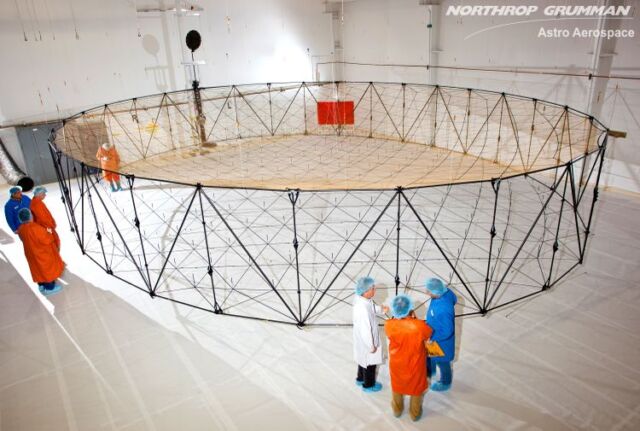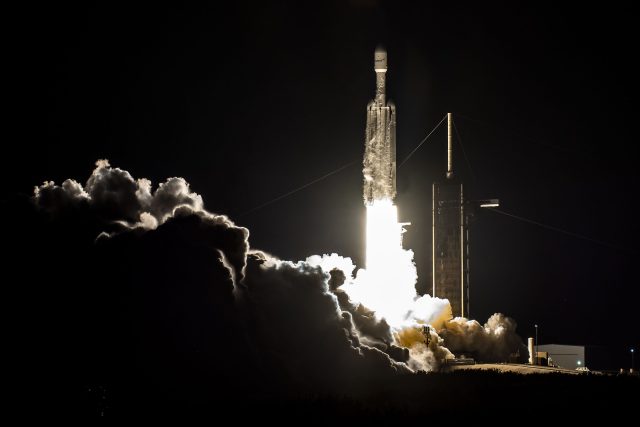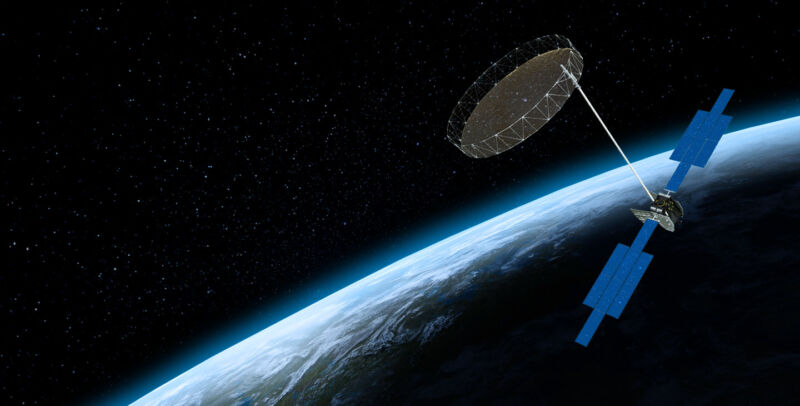A new Viasat communications satellite launched in April has been crippled by a problem when unfurling its huge mesh antenna. The problem jeopardizes Viasat’s much-needed refresh to its space-based Internet network that would let it better compete with newer broadband offerings from companies like SpaceX and OneWeb.
Viasat confirmed the antenna problem Wednesday after it was first reported by Space Intel Report. The satellite in question is named ViaSat-3 Americas, and it launched on April 30 as the primary payload on a SpaceX Falcon Heavy rocket from NASA’s Kennedy Space Center in Florida.
The satellite is one of the most powerful commercial spacecraft ever built, with two solar array wings as wide as a Boeing 767 jetliner capable of generating more than 30 kilowatts of electricity. The solar panels deployed soon after the spacecraft arrived in orbit, and the next step was to unfurl a large reflector to bounce Internet signals between the ground and transmitters and receivers on board the main body of the satellite.
That’s when ground controllers ran into trouble. An “unexpected event” occurred during the deployment of the reflector that may “materially impact” the performance of the satellite, Viasat said.
“We’re disappointed by the recent developments,” Mark Dankberg, chairman and CEO of Viasat, said in a statement. “We’re working closely with the reflector’s manufacturer to try to resolve the issue."
The ViaSat-3 Americas spacecraft remains in contact with ground controllers as they attempt to troubleshoot the problem. An industry source, speaking on the condition of anonymity, told Ars there was very little chance that ground teams would be able to fix the satellite’s antenna and fully recover the mission.
If Viasat declares it a total loss, the ViaSat-3 Americas satellite is insured for $420 million. That would be the largest known insurance claim for the loss of a satellite. But a person familiar with the space insurance market said the $420 million claim would not cover the entire cost of the mission. The San Diego Union-Tribune has reported the ViaSat-3 Americas mission cost about $700 million, leaving Viasat on the hook for the difference.
The space insurance official told Ars such a claim would be “disruptive” to the industry and may even trigger some underwriters to leave the space market.

Northrop Grumman's mesh-like satellite antenna, similar to but smaller than the reflector on the ViaSat-3 Americas spacecraft.
The mesh-like reflector antenna on the ViaSat-3 Americas satellite is made of reinforced polymers, graphite, and carbon fibre, with fine gold-plated wire woven into the structure to add flexibility and reduce weight. During launch, the antenna folded up against the spacecraft to fit inside the rocket’s payload shroud.
The spacecraft was built by Boeing, with a communications payload developed internally by Viasat. The reflector was supplied by Northrop Grumman’s Astro Aerospace, said Dave Ryan, Viasat’s president of space and commercial networks, in an interview before the launch in April.
Ryan said the deployment of the antenna was expected to take “literally days.” The reflector is attached to a boom 80 to 90 feet (about 25 meters) long, a larger derivative of the mid-booms that aided the deployment of the sunshade on the James Webb Space Telescope. Speaking before the launch, Viasat officials would not disclose the exact specifications of the circular parabolic antenna but said it was one of the largest structures of its kind ever flown in space.
The reflector is required to focus signals from the satellite onto a small location on the ground. It’s critical to enabling the satellite to reach thousands of users at once, with a total throughput of more than a terabit per second over its 15-year design life.
A huge setback for Viasat
The ViaSat-3 Americas satellite is the first of three identical new broadband relay platforms Viasat planned to launch over the course of the next year. It’s likely the launches of the next two ViaSat-3 satellites will be delayed to allow engineers to investigate the cause of the antenna deployment failure on the first spacecraft already in orbit.
Viasat is a major player in the growing business of providing broadband services from space. Unlike the constellations of broadband satellites operated by SpaceX and OneWeb in low-Earth orbit, Viasat has focused on developing larger, more powerful satellites positioned in geostationary orbit more than 22,000 miles (nearly 36,000 kilometers) over the equator, where their orbital speeds match the rate of Earth’s rotation.
That gives Viasat’s satellites fixed coverage zones, and a customer’s antenna on the ground can remain pointed at the same place in the sky to connect with the spacecraft. Viasat’s geostationary orbit architecture requires fewer satellites for global reach, but their distance from Earth results in longer latency Internet connections. They also need to be much larger and more expensive than SpaceX’s Starlink satellites, which the company mass-produces at a rate of about six per day and launches into orbit in large batches on a single rocket. SpaceX has launched more than 4,700 Starlink satellites to date.
SpaceX does not purchase insurance coverage for its Starlink launches, but other constellation operators do. Another company with deep pockets soon to enter the broadband-from-space business is Amazon, which aims to launch prototypes later this year for its Kuiper constellation, a network that will eventually consist of more than 3,200 Internet satellites.
Viasat and SpaceX have sparred for several years over federal broadband subsidies and claims by Viasat that the Starlink satellite constellation would raise the risk of collisions between objects in orbit. Despite the bad blood, Viasat selected SpaceX’s Falcon Heavy rocket to launch the satellite the company hoped would improve Viasat’s position in competition with the Starlink network.

The ViaSat-3 Americas satellite launched April 30 on a SpaceX Falcon Heavy rocket. Viasat requested
SpaceX expend all three boosters on the Falcon Heavy rocket to give its satellite a ride into a higher
orbit close to its final operating altitude.
SpaceX
Officially unveiled in 2016, the ViaSat-3 program is thought to represent an investment of more than $2 billion by Viasat, including the cost of three satellites, their communications payloads, launch services, ground infrastructure, and insurance. Viasat’s previous satellites covered only North America, and the ViaSat-3 program is designed to extend the company’s coverage globally.
Viasat’s satellites beam Internet signals for homes, businesses, and government users in regions where terrestrial fiber connectivity is unavailable. Based in Carlsbad, California, Viasat has agreements to provide in-flight Wi-Fi to passengers on Delta Air Lines, American Airlines, United Airlines, Southwest Airlines, JetBlue, and other commercial airlines.
The next two ViaSat-3 satellites were supposed to cover Europe, the Middle East, Africa, and the Asia-Pacific region. If necessary, Viasat said it could move one of its older spacecraft in orbit or reallocate one of the next two ViaSat-3 satellites still on the ground to provide broadband coverage over North and South America, at least partially replacing the capacity that was to be provided by ViaSat-3 Americas.
Viasat completed the acquisition of Inmarsat, another major satellite operator, in May for $7.3 billion. Taken together, the combined company has 19 large communications satellites in orbit, including 12 operating in Ka-band, the same piece of the radio spectrum used by the ViaSat-3 Americas satellite.
Shares of Viasat were down 30% since the company announced the antenna problem Wednesday.
Amateur astronomer detected signs of trouble
Viasat didn’t publicly reveal the reflector problem on its new satellite until this week, but an amateur astronomer and radio hobbyist in Canada had already discovered the spacecraft was in trouble.
Scott Tilley tweeted on July 8 that something seemed off with signals coming from the spacecraft parked more than 20,000 miles over the Americas. He often uses his home setup—an 80-centimeter dish and a host of radio gear with custom software—to track and identify spacecraft orbiting overhead, including top-secret US government and foreign spy satellites.
“Every once in a while, you notice something out of the ordinary,” Tilley told Ars.
The amplitude of the signal from ViaSat-3 Americas was fluctuating when Tilley would have expected it to be stable if the spacecraft was continuously pointing its antennas toward Earth. That suggested the satellite was regularly changing orientation, with engineers possibly trying to get the antenna to open by cycling it between hotter and colder temperatures, using sunlight and shadow to expand and contract the deployment mechanisms.
“They might have been trying to oscillate the antenna between heating and cooling,” Tilley said. “They might have been ‘shimmying’ the satellite … doing whatever they possibly could to free it up.”




3175x175(CURRENT).thumb.jpg.b05acc060982b36f5891ba728e6d953c.jpg)


Recommended Comments
There are no comments to display.
Join the conversation
You can post now and register later. If you have an account, sign in now to post with your account.
Note: Your post will require moderator approval before it will be visible.